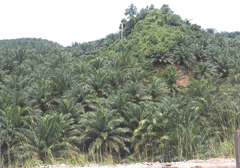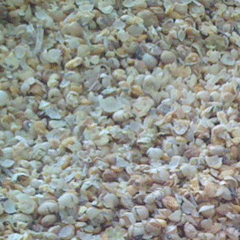Biofuel the Best Bet?
Air Date: Week of January 18, 2008

(Flickr/Badly Drawn Dad)
The European Union is re-thinking its commitment to use ten percent biofuel in vehicles because of growing concerns about some of the fuel’s sources, including corn, sugar and palm oil. Host Bruce Gellerman turns to Jim Lane, chairman of the American Biofuels Council, to get the latest on the future of biofuels.
Transcript
GELLERMAN: From the Jennifer and Ted Stanley Studios in Somerville, Massachusetts—this is Living on Earth. I’m Bruce Gellerman, in for Steve Curwood. Growing fears of global warming and our dependence on foreign oil, as well as soaring gas prices, have accelerated interest in biofuels…petroleum substitutes made from plants.
General Motors and Virgin Atlantic think the future of biofuels is bright. They’ve recently made major announcements involving plant-grown energy. But the European Union is taking a dim view of biofuels. To help sort the wheat from the chaff we turn to Jim Lane, editor of the online daily “Biofuels Digest” and chairman of the American Biofuels Council. Welcome, Jim.
LANE: Hi Bruce.
GELLERMAN: So when I say biofuels, exactly what, what am I talking about?
LANE: Biofuels are made from biomass, that is plants. They can be made from waste materials, they can be made from citrus peel, they could be made form wood chips, a lot of stuff that you wouldn’t think you could turn into fuel, and through a chemical process are transformed into something that you can put in your engine. And the good news there is because they use carbon when they’re grown, they take the carbon out of the sky, so what we’re putting into the sky when we burn a biofuel is just the carbon they took out in the first place, and that’s a good cycle, so they’re called carbon neutral and that’s why we like them.

Soybeans and soybean hulls. Soybean oil is the most common feedstock for first-generation biodiesel in the United States. Soybean hulls are a feedstock for second generation biofuels that use waste products, rather than foodstocks, to make fuel. (Photo: Jim Lane)
LANE: What the E.U. is saying is to think sustainable, not renewable. Not all renewable fuels are alike. Some of them can be made, for instance palm oil biodiesel can be made in Indonesia by deforesting large sections of primeval forest and not only is that bad for biodiversity, but it’s actually bad for the environment, because it releases a ton of carbon when we take down the forest so it sort of defeats the purpose, and what the E.U. is saying is let’s use renewable fuels, let’s do the right thing, let’s do it in a sustainable manner, and so in that sense they’re not really turning against biofuels, they’re actually leading us to a better biofuel.
GELLERMAN: Well, what could be a better biofuel?
LANE: A second-generation biofuel is made instead of from a food stock it’s made from waste. And that can be turned into fuel at a much lower cost than let’s say converting soy or corn into ethanol. So it’s good for the consumer on the cost frontier, it’s better for the environment, and it’s certainly using products that we don’t have any use for right now. So that’s, it’s really a win, win win if you will, and we’re all for it. The problem is whether it’s commercially viable and that’s something we’re exploring right now.

Jim Lane (Courtesy of Jim Lane)
LANE: This is a very exciting technology, it’s one of several out there. Its primary attribute is that it’s very low cost, and it has a low environmental impact. So it’s a, it’s a good sign that GM is getting serious about having long-term environmental and fuel strategy, and more power to them.
GELLERMAN: Well Virgin Atlantic airline says it’s going to fly an experimental plane in February fueled by biofuel. But they’re being very secretive about exactly which fuel they’re going to use.

Algae oil igniting in a biofuel production test. Algae is one of the most promising feedstocks for biofuels: it can yield up to 10,000 gallons per acre, consume carbon dioxide and grow in desert areas. (Photo: Jim Lane)
GELLERMAN: So it seems to me that these places that are rich in agricultural land and products could one day become basically the Saudi Arabias of the future.

Palm oil has become highly controversial as a biofuel feedstock because of deforestation practices in Southeast Asia. This photo of a palm oil plantation was taken in Borneo. (Photo: Flickr/Badly Drawn Dad http://www.flickr.com/photos/dhedwards/215383747/)
LANE: Yeah that’s very true. And that’s something that a lot of African countries are looking at. They have tremendous growing capabilities. They have a lot of land available and they have wonderful tropical characteristics. But also the Arabian countries are getting involved in biofuel development. The emirate of Abu Dhabi has got a major project going on because they see this as the future, or certainly a big part of it. So every community in the world should be looking at what they can do to develop a meaningful biofuels strategy, and not just become a consumer, but a sustainable producer and be part of the solution, and also build jobs and build a stronger economy for themselves. And that’s what’s happening in India and Africa and it’s a great story for those places that have been economically challenged for so long.
GELLERMAN: Jim Lane is editor of the online daily “Biofuels Digest” and chairman of the American Biofuels Council. Well Jim, thank you very much.
LANE: Thank you, Bruce.
Links
Living on Earth wants to hear from you!
Living on Earth
62 Calef Highway, Suite 212
Lee, NH 03861
Telephone: 617-287-4121
E-mail: comments@loe.org
Newsletter [Click here]
Donate to Living on Earth!
Living on Earth is an independent media program and relies entirely on contributions from listeners and institutions supporting public service. Please donate now to preserve an independent environmental voice.
NewsletterLiving on Earth offers a weekly delivery of the show's rundown to your mailbox. Sign up for our newsletter today!
 Sailors For The Sea: Be the change you want to sea.
Sailors For The Sea: Be the change you want to sea.
 The Grantham Foundation for the Protection of the Environment: Committed to protecting and improving the health of the global environment.
The Grantham Foundation for the Protection of the Environment: Committed to protecting and improving the health of the global environment.
 Contribute to Living on Earth and receive, as our gift to you, an archival print of one of Mark Seth Lender's extraordinary wildlife photographs. Follow the link to see Mark's current collection of photographs.
Contribute to Living on Earth and receive, as our gift to you, an archival print of one of Mark Seth Lender's extraordinary wildlife photographs. Follow the link to see Mark's current collection of photographs.
 Buy a signed copy of Mark Seth Lender's book Smeagull the Seagull & support Living on Earth
Buy a signed copy of Mark Seth Lender's book Smeagull the Seagull & support Living on Earth

